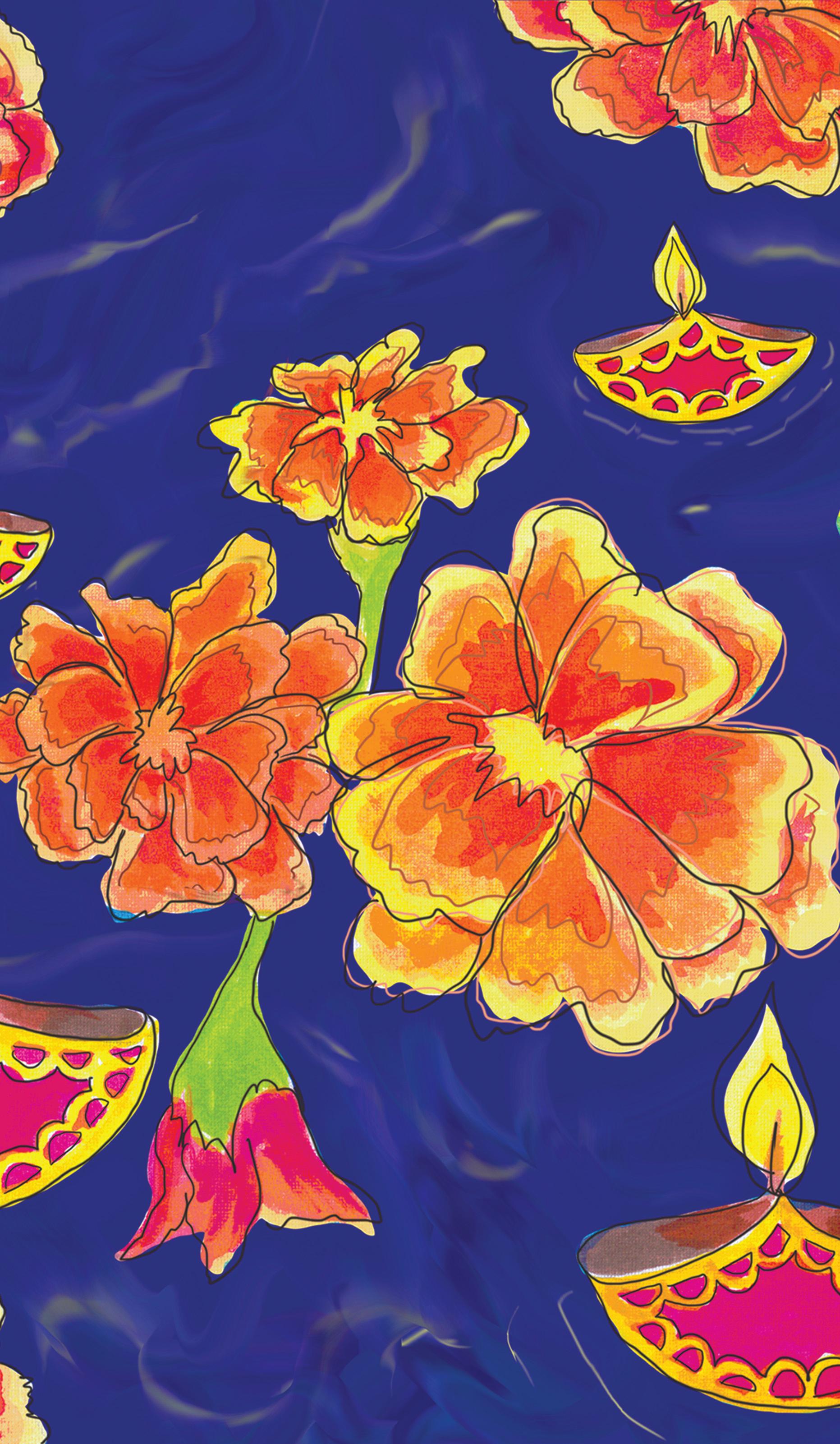
5 minute read
Mourning
by Misbah Ansari
Art by Ellie Zheng
Advertisement
I reminisce frantically penning down these lines last year at the funeral of my aunt. Women from the paternal side of my family are characterized by their widowhood, a case of uncanny marital fate, they say. When my aunt passed away last year, they said that she witnessed two demises—one her husband’s suicide and one her own. The two deaths built in her slowly and she died of a sudden breathless fit, my family suspects that her intestines burst due to the pressure of her death. Mourning is a wellpunctuated political act that dictates the grief of widows in hegemonic ways, thus, making the act of grief a highly dictated one.
Butler claims that perhaps mourning means “submitting” to a transformation, and it is worth questioning the intricacies of transformation concerning widowhood. The institution of marriage moulds women’s identities, and the hegemonic patriarchal system governs all the changes that take place in their lives in place. Transformations are otherwise empowering processes, but the transformative impact of loss is hardly planned. It is sudden, inalienable, and in the case of widows, forced. My aunt, just like me, a lover of the darkest lipsticks, fanciest hair clips and stitching the best clothes for herself, knew of happiness in her own life. She loved my uncle immensely, but in independence and comfortable isolation, however, people mixed their deaths. The way mourning is arbitrated for people who have lost their husbands makes us wonder: how is it that someone’s loss is so heavily mediated that the society decides what their mourning should look like? How does the transformation happen, and when does it stop? For widows, a husband’s death is less of a longitudinal change, but a short, tumultuous one followed by stagnancy. It is a declaration that your husband is dead, so now you give up all your worldly matters, move away from your family, and live in a stupor as governed.
The position of widows in Indian society perpetuates the adamant societal structures in controlling their bodies and identity. Nash (2013) grounds her argument about black love-politics in Affect theory, investigating how bodies interact with different emotional phenomena. The sexuality of widows is set in place by rigid norms to contain their high libidinal energy, and they are expected to lead a life of celibacy, utter modesty, or sex work, depending on their caste status (Ahmed-Ghosh, 2009). Apart from the erasure of identities, the sexuality of the lower caste is allowed as they are endowed with the labour of upholding the purity of the upper caste. The deployment of the sexuality of minorities is a way of controlling their image as sexually deviant and impure individuals, and this hierarchy is advertent in the lives of widows quite a lot. Their bodies interact with the vulnerable phenomena of longing and desire in hegemonically mediated emotions, for their sexuality is not their own. It is laboured, strewn, and empty. Butler elaborated on our bodies never being our own and
scrutinized to others’ violence, gaze, and agency. For my aunt lost, or was made to lose, her trinkets of enjoyment that she associated with deeply and her mourning was said to be a lifelong one.
In my poem, I count the amount of time I mourned the losses of different things —I mourned about the death of my only plant for exactly 2 minutes today. Then it was automatically slurped by my vacuum cleaner.
To be able to not hold your grief permanently and to dictate your own sadness is a privilege; I let there be temporary changes in my life post losses because this sadness is mine, and I decide its importance. My aunt, in her widowhood, had to hold a funeral to her intestines all her life and become distant from her own love.
To summarize, I am tempted to quote Butler — “Individuation is an accomplishment” (16). The sheer privilege of getting to lead individual lives and having community intervention in its truest sense is a rarity, and maybe that is why I called it an abbreviation for a longer feeling in my poem. Not to call it a masquerade, but maybe it masks the complicated politics of love and belonging. Arundhati Roy (1997) coined the term “Love Laws” that decide who should receive love, and Butler inquired about who lives are considered mourn-worthy (22). The lives of widows, or the forced performance of sadness inflicted upon them, maintains the pompousness with which patriarchy decides that some life must be grieved forever. Men, especially married men, get the privilege of being put on a pedestal even after death. Furthermore, empowerment is such a vague concept with a certain archetype that creates a false image of state-run love in our minds. It glorifies waiting for the non-reciprocal, and long waiting period a multicultural state makes people go through, further strengthening the nation’s power dynamics. Thus, widowhood is placed under the realm of vulnerability which is reflected in the Indian setting immensely. Ahmed, S. (2014). In the Name of Love. In Cultural politics of emotion (pp. 122-143). Edinburgh, UK: Edinburgh University Press. Ahmed-Ghosh, H. (2009). Widows in India: issues of masculinity and women’s sexuality. Asian Journal of Women’s Studies, 15(1), 26-53. Butler, J. (2003). Violence, mourning, politics. Studies in gender and sexuality, 4(1), 9-37. Ehlers, N. (2011). Onerous passions: colonial antimiscegenation rhetoric and the history of sexuality. Patterns of Prejudice, 45(4), 319-340. Mehta, A. (Director). (2005). David Hamilton. United States: 20th Century Fox. Mastey, N. (2009). Examining empowerment among Indian widows: A qualitative study of the narratives of Hindu widows in North Indian ashrams. Journal of International Women’s Studies, 11(2), 191198 Nash, J. C. (2013). Practicing love: Black feminism, love-politics, and postintersectionality. Meridians, 11(2), 1-24. Roy, A. (2001). The god of small things. Pune, India: Mehta Publishing House.











